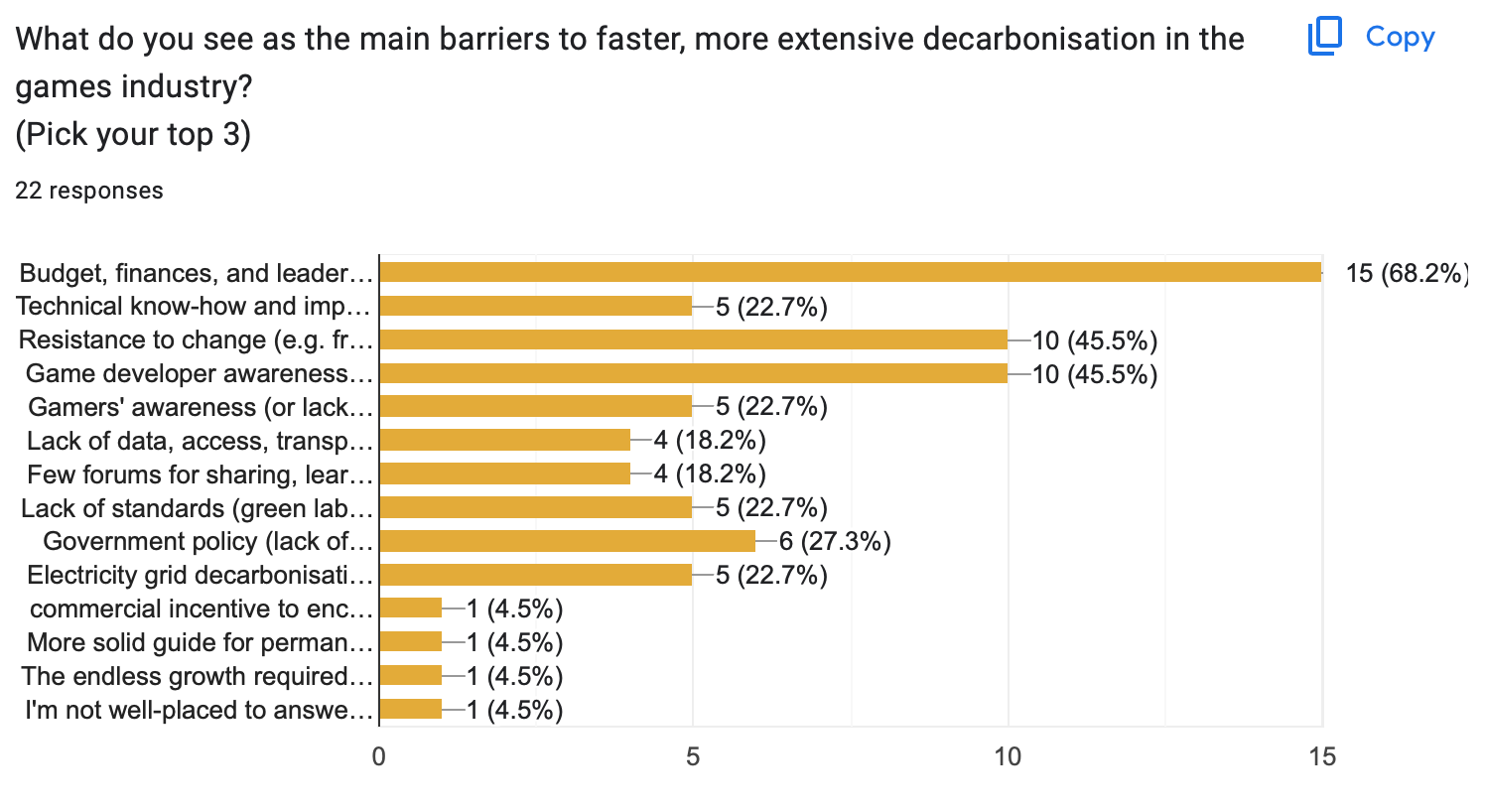An update on Scope 3 upstream development emissions & the results of the GTG reader survey

This week I wanted to get out the second part of my series on the footprint of the games industry, looking at game distribution emissions. Alas, I didn’t finish it in time so instead, here’s a short update on the figures from last time – plus the results of the GTG reader survey.
After my previous post on game development’s contribution to the industry's annual footprint, Nicolas Hunsinger Ubisoft’s Environmental Sustainability Director reached out with some feedback on my use of their numbers, specifically the multiplication factor based on Ubisoft’s Upstream Scope 3. As Nicolas writes:
the multiplicator that you take from Ubisoft to assess scope 3 upstream is too high (remember that Ubisoft's scopes 1&2 is very low because we are close to 100% renewable).
He’s right Ubisoft does have a pretty low Scope 2 footprint, with a figure of only 14,905 tCO2e in 2021 (using the market-based method) for their 20,665 staff. It also sounds like the percentage of renewables in that has improved, as in last year’s report (covering 2021 don’t forget – the time lag on these things is a drag!) the percentage of renewable electricity was 67% but Nicolas would know of course what it’s at currently. It’s encouraging to hear that it has gone even higher since. What’s the average split of renewables to non-renewable power in the games industry though? Your guess is as good as mine. But perhaps another approach is to use the location-based calculation method. Because these aren’t weighted by a company’s purchase of renewables but by the intensity of the local grid in each location (and Ubisoft is nothing if not a global organisation), this might give us an alternative window on the issue.
If we take Ubisoft’s location-based Scope 2 emissions, their annual Scope 2 figure was 25,507 tCO2e, which means the ratio of Scope 1+2 to upstream Scope 3 shifts from being just 13% of emissions to 18% of total emissions (let’s round it to 20% because it just makes things a lot simpler). Even though this is not going to be the same as if we calculated location-based emissions for the entire games industry, it’s probably closer to the result we might get.
So now, with Ubisoft’s location based figures we have a ratio of Scopes 1 & 2 to Scope 3 that’s more like 1:4 rather than 1:7, and a revised plausible total game development emissions (upstream) figure that now ranges from 2 to 60 million tonnes of CO2e. That’s a bit more reasonable, I think.
Comparable countries with an emissions footprint to the extreme top-end of game development under this scenario shift to much smaller ones: Singapore (65M tonnes), Belarus (61M tonnes) and North Korea (58M tonnes). Again, the same caveats apply as last time – these are the theoretical maximum emissions from the entire upstream value chain of game development. The real figure is probably lower than the top end, but probably well above the very bottom figure of 2 million tonnes of CO2e.
If you’re having trouble following all of that, don’t stress. The important thing to know is that the real emissions footprint of game development is probably about half what I thought it could have been in the previous post. So thanks for the tip, Nicholas! This is why it’s so important to have good data, and clear, detailed disclosures! There are still many more factors that we could integrate to refine these estimates with better data (starting with a better idea of the locations of game studios, alongside the various location-based intensities of their energy grids).
In any case, a special thank you to Nicolas and the rest of his team at Ubisoft who put together ridiculously thorough ESG reports, which represents a huge amount of work. You are my heroes, for real.
While we’re here, let’s also take a look at the results of our reader survey. We had just over 20 responses, which means we got almost a 20% response rate – which ain’t too bad. Thank you again to everyone who took the time to fill it out.
The makeup of responders is perhaps unsurprisingly very weighted towards professional game developers of some sort (54%) with the next highest category being sustainability professionals (25%) almost all of whom work in the games industry.
We are really here for your views on “the main barriers to faster, more extensive decarbonisation in the games industry” though, so here are the full results:

If we add up all the responses, we get 68 choices made by 22 respondents, for an average of 3.09 picks per response. Someone cheated and picked more than 3! 😱
15 out of 22 responses picked “Budget, finances, and leadership support” as one of the main barriers – the highest of all the options. The next closest was a tie between “resistance to change from major hardware/software platforms” and “game developer awareness or lack thereof”. I think broadly that maps to my impressions of what, or where, the big hurdles are currently as well. When I talk to ordinary people and tell them that I am working to green the games industry and reduce its climate impact, it’s often the first time that most people have ever considered that games have a climate impact. For many game industry C-level decision-makers, I think climate hasn’t been on their radar until fairly recently, for some it is still a bit of an afterthought, and others don’t seem to have it on their radar at all. There are exceptions to this characterisation, and momentum does seem to be building though. The games industry is a hard business, and I don’t necessarily envy those in charge of it, but with great power comes great responsibility, as they say.
What I hope happens in the next few years is we reach some sort of tipping point, where the cost of inaction and inattentiveness becomes higher than the cost of just simply getting on with it, and getting it right. What does that tipping point look like? It could be new regulations. It could be a huge upswell of game developer demand for action, prompted perhaps by the burgeoning Game Developer Rebellion (similar to other Extinction Rebellion offshoots like ‘Scientists Rebellion’) which a few subscribers to this very newsletter are involved in, over at the IGDA Climate SIG. (Join the discord!) It could be investors getting extremely scared about the potential for stronger climate action and dumping risk-exposed companies. Or it could be something else market based, like a proposed carbon price with real teeth, or a repeat of the 2022 European gas crisis that saw gas prices skyrocket challenging bottom lines and budgets. It could also be something naturally disastrous, like a catastrophic climate event that galvanises the games community – remember the bomb cyclone that hit SF during GDC week? The worst I got was quite wet this time, but atmospheric rivers are getting stronger and holding more moisture as the climate warms. I hope it doesn’t take something as bad as that.
Resistance to change by software and hardware platforms is an interesting one, and remarkably tricky still. When I started this newsletter last year I did so with a post about gaming hardware and its role in locking in a certain level of gamer energy use. Those efforts mostly stalled out, after meeting with the EU energy efficient games consoles group mid-last year and running into resistance to a power cap in the active gaming use phase. I even recognised the legitimacy of aspects of their rationale for it. But the fact remains that there are aspects of the games hardware business that are not sustainable, and the power profile of consoles over the next decade does matter.
It’s also interesting to compare “game developers awareness” to “gamers awareness” – twice as many people picked game developer awareness as a barrier to faster action than gamer awareness. That’s encouraging, for a few reasons. One is that I think it’s perhaps an accurate reflection of who has the power or capacity for action on game industry emissions. Developers can have collective power in their workplace (though it is not automatic) and have some say in decisions that make a difference to sustainability. Again, the IGDA Climate SIG is doing great work here to help produce resources and guides on how to form a climate council at a game studio. But another reason it’s encouraging is that there are far fewer game developers in the world than there are gamers. Pragmatically, it seems a little more achievable to reach them than the billions of gamers. We can do both, of course, but in terms of who has an easier time reaching for the levers of power, I know who I’m picking. My experience over the years with game developers has been that many of them are very socially minded and conscious of justice and equity issues, and I suspect there’s a growing environmental consciousness as well.
What’s most remarkable though is that there weren’t many options (besides a few of the write-ins) that weren’t at least a few people’s choice. That in itself is interesting – that there’s no real consensus on what is not a barrier. At least some people are still seeing “technical know-how and implementation of decarbonisation solutions” as a blocker, even as knowledge and expertise in the industry about solutions have grown massively over the past few years. Some are seeing the need for more government and policy, the lack of markets, incentives, taxes and so on, as a barrier. And some are seeing a lack of standards, green metrics or ratings as a barrier.
Lots to think about!
Also, if you have suggestions or corrections for anything I post here – I think I've figured out how to make it so you can simply hit reply to this email to shoot me a message. Neat!